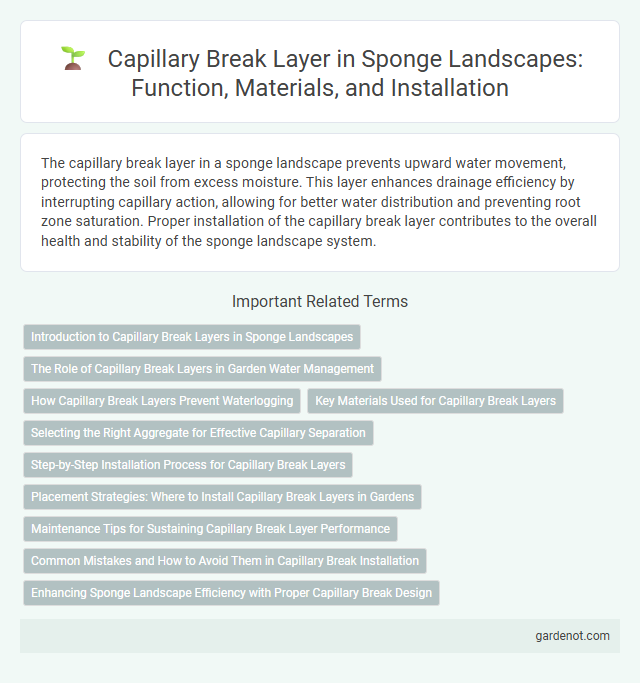The capillary break layer in a sponge landscape prevents upward water movement, protecting the soil from excess moisture. This layer enhances drainage efficiency by interrupting capillary action, allowing for better water distribution and preventing root zone saturation. Proper installation of the capillary break layer contributes to the overall health and stability of the sponge landscape system.
Introduction to Capillary Break Layers in Sponge Landscapes
A capillary break layer in sponge landscapes acts as a barrier that prevents upward water movement from saturated soils, enhancing drainage and promoting optimal soil moisture conditions for vegetation. Typically composed of coarse materials like gravel or sand, this layer interrupts the capillary rise of water, reducing waterlogging and increasing infiltration efficiency. Implementing capillary break layers supports sustainable urban drainage systems by improving groundwater recharge and minimizing surface runoff.
The Role of Capillary Break Layers in Garden Water Management
Capillary break layers, composed of coarse materials like gravel or sand, play a crucial role in garden water management by preventing the upward movement of water through soil, thus reducing waterlogging and root rot. These layers enhance soil drainage and improve aeration, ensuring optimal moisture levels for plant growth. By regulating water distribution, capillary break layers contribute to healthier landscapes and more efficient water use in sustainable gardening practices.
How Capillary Break Layers Prevent Waterlogging
Capillary break layers prevent waterlogging by interrupting the upward movement of water through soil pores, ensuring excess water drains away instead of accumulating near plant roots. These layers typically consist of coarse, well-draining materials like sand or gravel, which create a barrier that reduces capillary rise and promotes proper soil aeration. Effective implementation of a capillary break layer is crucial in sponge landscape design to maintain optimal moisture levels and prevent root oxygen deprivation.
Key Materials Used for Capillary Break Layers
Key materials used for capillary break layers in sponge landscapes include coarse sand, gravel, and geotextile fabrics known for their high permeability and durability. These materials effectively prevent water migration by creating a physical barrier that disrupts capillary action, ensuring optimal drainage and moisture control. Selecting the right particle size distribution and texture enhances soil stability while maintaining efficient water flow beneath sponge landscape systems.
Selecting the Right Aggregate for Effective Capillary Separation
Selecting the right aggregate for an effective capillary break layer in sponge landscaping is critical to prevent moisture migration and soil saturation. Coarse, uniformly graded aggregates such as clean gravel or crushed stone with particle sizes typically between 10 to 40 mm create optimal void spaces for capillary discontinuity. Properly sized aggregates improve drainage efficiency and maintain soil structure integrity, ensuring long-term landscape durability.
Step-by-Step Installation Process for Capillary Break Layers
Install the capillary break layer by first preparing a clean, level base to prevent water from moving upward through soil pores. Lay a geotextile fabric or coarse aggregate evenly across the foundation to serve as a barrier against capillary rise. Ensure proper overlap and compact gently to maintain consistent thickness, enhancing drainage and protecting the sponge landscape structure.
Placement Strategies: Where to Install Capillary Break Layers in Gardens
Capillary break layers in sponge landscapes should be installed directly below the topsoil or planting medium to prevent upward water movement and reduce soil moisture saturation. Positioning these layers above impermeable sublayers or compacted soils enhances drainage and protects plant roots from waterlogging. Proper placement in garden beds and around plant root zones ensures optimal water management and promotes healthier vegetation growth.
Maintenance Tips for Sustaining Capillary Break Layer Performance
Regular inspection of the capillary break layer ensures free drainage and prevents soil clogging, maintaining optimal water movement. Keeping the layer clear of debris and root intrusion extends its effectiveness in controlling moisture flow within the sponge landscape system. Periodic flushing or aeration helps preserve permeability, supporting long-term durability and landscape health.
Common Mistakes and How to Avoid Them in Capillary Break Installation
Common mistakes in capillary break installation include improper material selection, inadequate thickness, and poor surface preparation, which compromise moisture control in sponge landscapes. Using crushed stone or coarse sand with sufficient particle size and ensuring a continuous, uniform layer effectively prevent capillary rise and water infiltration. Performing a detailed site assessment and following manufacturer guidelines for layer placement optimize capillary break performance and longevity.
Enhancing Sponge Landscape Efficiency with Proper Capillary Break Design
A properly designed capillary break layer significantly enhances sponge landscape efficiency by preventing water from seeping downward and ensuring optimal moisture retention in the root zone. Materials such as geotextiles, gravel, or sand create effective barriers that maintain necessary moisture balance for vegetation health. Implementing these layers improves groundwater recharge and reduces surface runoff, promoting sustainable urban drainage systems.
Capillary break layer Infographic

 gardenot.com
gardenot.com